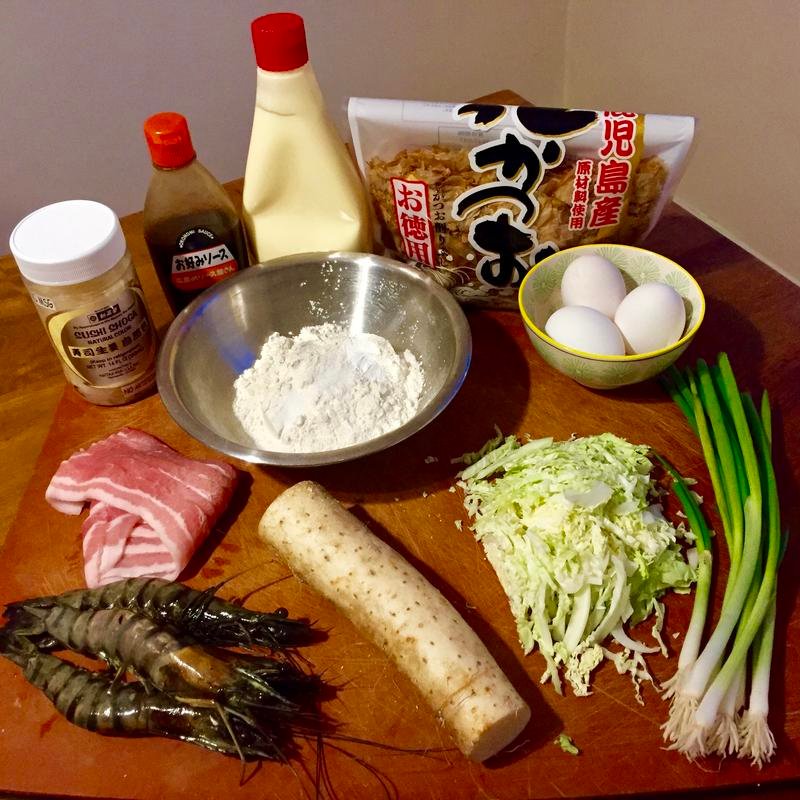
Okonomiyaki translated to english basically means "grilled how you like". It is a savory pancake that is easily in my top ten, all time favorite foods. To say that it is a savory pancake is an understatement. Nearly every ingredient in this dish is full of richly satisfying umami flavor. The pancake can be made with nearly any ingredient that you like or have on hand. In the version that I made today I added to the batter diced shrimp, shredded cabbage, broccoli slaw (I did not have enough cabbage), pickled ginger and sliced scallions. I topped the pancake with thinly sliced fresh pork belly. This pork cooks to crispy perfection as the pancake finishes cooking. When the pancake is finished cooking I top it with okonomiyaki sauce (basically oyster sauce and ketchup), Japanese mayonnaise, strips of nori (crispy seaweed), bonito flakes (thinly shaved dried tuna) and Japanese chili powder. I add extra bonito flakes to my pancake and I also use the big thick flakes that normally go into make dashi broth. Usually you will get a thinner and finely sliced bonito for this dish. But, I really enjoy that "smokey" tuna flavor.
Ingredients
Here are the basic ingredients that I used to make the okonomiyaki. The cylinder shaped vegetable below is called nagaimo. It is a type of yam that grates to a big slimy mess! Later in the post I have a video of this. Nagaimo adds a creaminess and lightness to the batter that really makes the pancake perfect. The slimy texture of the yam is complete gone when the pancake is cooked. You can find this yam at Japanese grocery stores or online. I use Kewpie Japanese mayonnaise in this dish because it has a light, creamy texture and a deeply satisfying tangy flavor. I also use bottled okonomiyaki sauce because it tastes great. Sometimes bottled sauces are the perfect choice.

I have tried many recipes and have discovered that I like my batter to be on the thicker side. Once you add all your fillings to the batter it really holds its shape when cooking. I find that the ratio of dry to wet ingredients in the recipe below from www.justonecookbook.com is nearly perfect. I made a few changes and they are listed in parenthesis after the ingredient.
- 1 cup all-purpose flour
- ¼ tsp kosher salt
- ¼ tsp granulated sugar
- ¼ tsp baking powder
- 2-3 inch piece of Nagaimo grated
- ¾ cup dashi (I used water, but normally use dashi)
- 1 large cabbage head shredded (I use a half of a cabbage at most)
- ½ lb sliced pork belly ( I used about 1/4 pound)
- 4 large eggs
- ½ cup Tenkasu/Agedama ( I did not used these but would if I had them)
- ¼ cup pickled red ginger
- neutral flavor oil
Additional ingredients that I added to the batter
- 4 large shrimp diced
- 1/2 cup sliced scallions
Method
Here is the video of the grated nagaimo. Check out how slimy it is!
- In one bowl add the flour, salt, sugar and baking powder.
- In another bowl whisk together the grated nagaimo, dashi and eggs
- Stir the wet ingredients into the dry ingredients.
- Then fold in the shrimp, scallions and cabbage.
- Heat oil in a pan and cook the pancake for 4 minutes on medium-low heat.
- Add the strips of pork belly on top and then flip the pancake and cook for 4 more minutes.
- Remove the pancake and slice it into wedges then transfer it to a serving dish.
- Top off the pancake with okonomiyaki sauce, mayonnaise, nori, dried bonito flakes and Japanese chili powder.
Here is the batter with the fillings added

Cooking the pancake

Adding the pork belly

Topped with the sauces and other toppings

One of my favorite parts of having okonomiyaki is when you are just about to eat it. The heat from the pancake travels up through the bonito flakes and the whole dish appears to be dancing!

Taking a piece

Finally it is time to enjoy the first bite!

Remember that okonomiyaki is to be made as you like it. A good idea for a small informal dinner party is to make up a big batch of the batter with just the cabbage in it. Then put out different fillings and toppings. Make one or two pancakes at a time. Each pancake is designed by a different guest. But, you all eat the same pancake together (family style) and then make another and another...
I hope you have enjoyed this post today and that you learned something. I hope I have inspired you to try a new dish or to revisit an old favorite. I really enjoy engaging with everyone in the comments section below. I hope to see you there!
Also, if you missed the first three posts in this series you can find them here:
@chefsteve/japanese-food-series-part-1-ramen
@chefsteve/japanese-food-series-part2-gyoza
@chefsteve/japanese-food-series-part-3-chicken-karaage
Chef Steve

